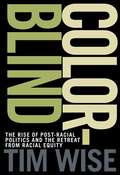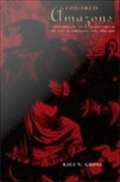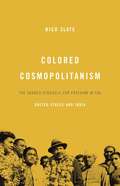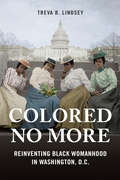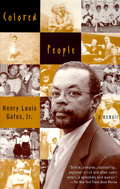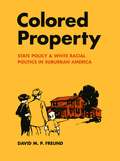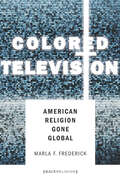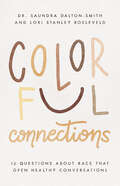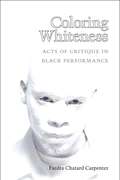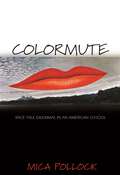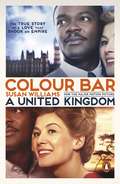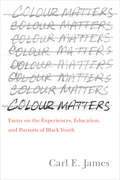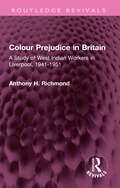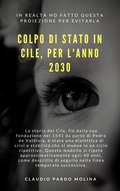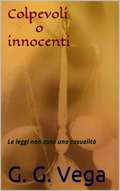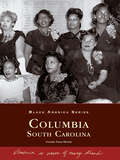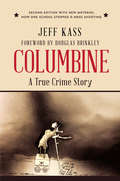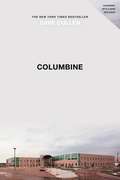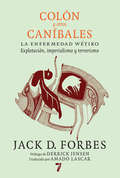- Table View
- List View
Colorblind: The Rise of Post-racial Politics and the Retreat from Racial Equity
by Tim WiseThis powerful (and certain to be controversial) book takes aim at the common assertion that the election of Barack Obama led the US into a post-racial age. Instead, Wise asserts, the deployment of "color- blind" policies is not only a bad way to implement a progressive political agenda, but they undermine efforts to deal with race-based social and economic inequality and lend credence to right-wing arguments that these inequalities are due to innate problems in black and brown communities. As a remedy, the author suggests color- conscious policy-making as the best way to promote fairness in US society. Annotation ©2010 Book News, Inc. , Portland, OR (booknews. com)
Colored Amazons: Crime, Violence, and Black Women in the City of Brotherly Love, 1880-1910
by Kali N. GrossColored Amazons is a groundbreaking historical analysis of the crimes, prosecution, and incarceration of black women in Philadelphia at the turn of the twentieth century. Kali N. Gross reconstructs black women's crimes and their representations in popular press accounts and within the discourses of urban and penal reform. Most importantly, she considers what these crimes signified about the experiences, ambitions, and frustrations of the marginalized women who committed them. Gross argues that the perpetrators and the state jointly constructed black female crime. For some women, crime functioned as a means to attain personal and social autonomy. For the state, black female crime and its representations effectively galvanized and justified a host of urban reform initiatives that reaffirmed white, middle-class authority. Gross draws on prison records, trial transcripts, news accounts, and rare mug shot photographs. Providing an overview of Philadelphia's black women criminals, she describes the women's work, housing, and leisure activities and their social position in relation to the city's native-born whites, European immigrants, and elite and middle-class African Americans. She relates how news accounts exaggerated black female crime, trading in sensationalistic portraits of threatening "colored Amazons," and she considers criminologists' interpretations of the women's criminal acts, interpretations largely based on notions of hereditary criminality. Ultimately, Gross contends that the history of black female criminals is in many ways a history of the rift between the political rhetoric of democracy and the legal and social realities of those marginalized by its shortcomings.
Colored Cosmopolitanism: The Shared Struggle For Freedom In The United States And India
by Nico SlateA hidden history connects India and the United States, the world's two largest democracies. From the late nineteenth century through the 1960s, activists worked across borders of race and nation to push both countries toward achieving their democratic principles. At the heart of this shared struggle, African Americans and Indians forged bonds ranging from statements of sympathy to coordinated acts of solidarity. Within these two groups, certain activists developed a colored cosmopolitanism, a vision of the world that transcended traditional racial distinctions. These men and women agitated for the freedom of the "colored world," even while challenging the meanings of both color and freedom.
Colored No More: Reinventing Black Womanhood in Washington, D.C. (Women, Gender, and Sexuality in American History)
by Treva B. LindseyHome to established African American institutions and communities, Washington, D.C., offered women in the New Negro movement a unique setting for the fight against racial and gender oppression. Colored No More traces how African American women of the late-nineteenth and early twentieth century made significant strides toward making the nation's capital a more equal and dynamic urban center. Treva B. Lindsey presents New Negro womanhood as a multidimensional space that included race women, blues women, mothers, white collar professionals, beauticians, fortune tellers, sex workers, same-gender couples, artists, activists, and innovators. Drawing from these differing but interconnected African American women's spaces, Lindsey excavates a multifaceted urban and cultural history of struggle toward a vision of equality that could emerge and sustain itself. Upward mobility to equal citizenship for African American women encompassed challenging racial, gender, class, and sexuality status quos. Lindsey maps the intersection of these challenges and their place at the core of New Negro womanhood.
Colored People
by Henry Louis GatesFrom an American Book Award-winning author comes a pungent and poignant masterpiece of recollection that ushers readers into a now-vanished "colored" world and extends and deepens our sense of African-American history, even as it entrances us with its bravura storytelling.
Colored Property: State Policy And White Racial Politics In Suburban America
by David M. P. FreundNorthern whites in the post–World War II era began to support the principle of civil rights, so why did many of them continue to oppose racial integration in their communities? Challenging conventional wisdom about the growth, prosperity, and racial exclusivity of American suburbs, David M. P. Freund argues that previous attempts to answer this question have overlooked a change in the racial thinking of whites and the role of suburban politics in effecting this change. <p><p> In Colored Property, he shows how federal intervention spurred a dramatic shift in the language and logic of residential exclusion—away from invocations of a mythical racial hierarchy and toward talk of markets, property, and citizenship. Freund begins his exploration by tracing the emergence of a powerful public-private alliance that facilitated postwar suburban growth across the nation with federal programs that significantly favored whites. <p> Then, showing how this national story played out in metropolitan Detroit, he visits zoning board and city council meetings, details the efforts of neighborhood “property improvement” associations, and reconstructs battles over race and housing to demonstrate how whites learned to view discrimination not as an act of racism but as a legitimate response to the needs of the market. <p> Illuminating government’s powerful yet still-hidden role in the segregation of U.S. cities, Colored Property presents a dramatic new vision of metropolitan growth, segregation, and white identity in modern America.
Colored Television
by Marla FrederickThe presence of women and African Americans not simply as viewers, but also as televangelists and station owners in their own right has dramatically changed the face of American religious broadcasting in recent decades. Colored Television looks at the influence of these ministries beyond the United States, where complex gospels of prosperity and gospels of sexual redemption mutually inform one another while offering hopeful yet socially contested narratives of personal uplift. As an ethnography, Colored Television illuminates the phenomenal international success of American TV preachers like T.D. Jakes, Creflo Dollar, Joyce Meyer, and Juanita Bynum. Focusing particularly on Jamaica and the Caribbean, it also explores why the genre has resonated so powerfully around the world. Investigating the roles of producers, consumers, and distributors, Marla Frederick takes a unique look at the ministries, the communities they enter, and the global markets of competition that buffer them.
Colored White: Transcending the Racial Past
by David R. RoedigerColored White is a strong, jargon-free polemic that urges us to understand race as a formative part of American history. Roediger examines figures ranging from W.E.B. DuBois to Rush Limbaugh to show how we must understand race historically. He shows that racism is not merely a matter of demographics: it is political, and must be fought politically.
Colorful Connections: 12 Questions About Race that Open Healthy Conversations
by Lori Stanley Roeleveld Dr Saundra Dalton-SmithEncourages ordinary Christians to engage in real talk together about race and changeThere are a lot of conversations happening in homes and churches about difficult and timely topics--but when it comes to race, too many Christians stay silent. They may be overwhelmed, or worry about saying the wrong thing.Saundra Dalton-Smith and Lori Stanley Roeleveld--two women of different races who didn't know each other well before this project--believe there's a clear path to meaningful discussion about racism with someone of a different skin color. Instead of avoiding hard conversations, they enter a transparent and open dialogue about race, privilege, bias, and discrimination.Readers will witness a real-time process as these two women walk their journey of self-reflection, discovery, and healing. Lori and Saundra demonstrate how to give voice to pain without blame, how to express anger without ridicule, and how to ask questions without guilt. After reading the pages filled with vulnerable personal stories, biblical teaching, conversation starters, and practical next steps readers will be equipped to have their own healthy conversations.This book is for all who see God in ethnic diversity and want to be part of a true and deep understanding process. In these pages, there is hope to heal the racial divide and bring together the body of Christ.
Coloring Whiteness: Acts Of Critique In Black Performance
by Faedra Chatard CarpenterColoring Whiteness pays homage to the ways that African American artists and performers have interrogated tropes and mythologies of whiteness to reveal racial inequalities, focusing on comedy sketches, street theater, visual art, video, TV journalism, and voice-over work since 1964. By investigating enactments of whiteness—from the use of white makeup and suggestive masks, to literary motifs and cultural narratives regarding “white” characteristics and qualities—Faedra Chatard Carpenter explores how artists have challenged commonly held notions of racial identity. Through its layered study of expressive culture, her book considers how artistic and performance strategies are used to “color” whiteness and complicate blackness in our contemporary moment. Utilizing theories of performance and critical race studies, Coloring Whiteness is also propelled by Carpenter’s dramaturgical sensibilities. Her analysis of primary performance texts is informed not only by traditional print and visual materials, but also by her interviews with African American theater artists, visual artists, and cultural critics. The book is an invaluable contribution to the fields of theater and performance studies, African American studies, cultural studies, critical race studies, and American studies.
Colormute: Race Talk Dilemmas in an American School
by Mica PollockThis book considers in unprecedented detail one of the most confounding questions in American racial practice: when to speak about people in racial terms. Viewing "race talk" through the lens of a California high school and district, Colormute draws on three years of ethnographic research on everyday race labeling in education. Based on the author's experiences as a teacher as well as an anthropologist, it discusses the role race plays in everyday and policy talk about such familiar topics as discipline, achievement, curriculum reform, and educational inequality. Pollock illustrates the wide variations in the way speakers use race labels. Sometimes people use them without thinking twice; at other moments they avoid them at all costs or use them only in the description of particular situations. While a major concern of everyday race talk in schools is that racial descriptions will be inaccurate or inappropriate, Pollock demonstrates that anxiously suppressing race words (being what she terms "colormute") can also cause educators to reproduce the very racial inequities they abhor. The book assists readers in cultivating a greater understanding of the pitfalls and possibilities of everyday race talk and clarifies previously murky discussions of "colorblindness." By bridging the gap between theory and practice, Colormute will be enormously helpful in fostering ongoing conversations about dismantling racial inequality in America.
Coloso
by Niall Ferguson¿Es Estados Unidos el imperio del nuevo mundo? El gobierno estadounidense lo niega rotundamente. A pesar de la conquista de dos estados soberanos en un plazo de dos años, a pesar de la presencia de 750 bases o instalaciones militares en más de 130 países y a pesar de su expresa intención de «extender los beneficios de la libertad ... a todos los rincones del mundo», George W. Bush mantiene que «América nunca ha sido un imperio». Para Ferguson, el imperio americano carece de tres de los rasgos básicos que conformaron el imperialismo británico en el siglo XIX: necesita importar capital del resto del mundo para financiar su déficit fiscal y comercial, carece del número necesario de militares y diplomáticos para hacer de policía del mundo, y no tiene la voluntad decidida para perseverar en sus aventuras internacionales. En Coloso, Niall Ferguson traza la historia del poder de Estados Unidos a lo largo del siglo XX y revela la paradójica realidad de que, siendo el imperio más poderoso que haya conocido el mundo, se niega a aceptar las responsabilidades políticas y morales que conlleva el hecho de ser un poder global. «Un libro brillante lleno de energía, imaginación y curiosidad.» HUGH THOMAS, Evening Standard «Ferguson considera que la única esperanza para el futuro de muchos países reside en que un poder extranjero ... logre construir la paz y los pilares institucionales que resultan imprescindibles para su desarrollo económico. La polémica está servida.»RAIMUNDO ORTEGA, Cinco Días
Colour Bar: The Triumph of Seretse Khama and His Nation
by Susan WilliamsSir Seretse Khama, the first President of Botswana and heir apparent to the kingship of the Bangwato people, brought independence and great prosperity to his nation after colonial rule. But for six long years from 1950, Seretse had been forced into exile in England, banned from his own country. His crime? To fall in love and marry a young, white English girl, Ruth Williams. Delving into newly released records, Susan Williams tells Seretse and Ruth's story - a shocking account of how the British Government conspired with apartheid South Africa to prevent the mixed-race royal couple returning home. But it is also an inspiring, triumphant tale of hope, courage and true love as with tenacity and great dignity Seretse and Ruth and the Bangwato people ovecome prejudice in their fight for justice.
Colour Matters: Essays on the Experiences, Education, and Pursuits of Black Youth
by Carl E. JamesBased on research conducted in Black communities, along with over thirty years of teaching experience, Colour Matters presents a collection of essays that engages educators, youth workers, and policymakers to think about the ways in which race shapes the education, aspirations, and achievements of Black Canadians. Informed by the current socio-political Canadian landscape, Colour Matters covers topics relating to the lives of Black youth, with particular, though not exclusive, attention to young Black men in the Greater Toronto Area. The essays reflect the issues and concerns of the past thirty years, and question what has changed and what has remained the same. Each essay is accompanied by an insightful response from a scholar engaging with topics such as immigration, schooling, athletics, mentorship, and police surveillance. With the perspectives of scholars from the United Kingdom, the United States, and Canada, Colour Matters provides provocative narratives of Black experiences that alert us to what more might be said, or said differently, about the social, cultural, educational, political, and occupational worlds of Black youth in Canada. This book probes the ongoing need to understand, in nuanced and complex ways, the marginalization and racialization of Black youth in a time of growing demands for a societal response to anti-Black racism.
Colour Prejudice in Britain: A Study of West Indian Workers in Liverpool, 1941-1951 (Routledge Revivals)
by Anthony H. RichmondFirst published in 1954, Colour Prejudice in Britain is an account of the assimilation and adjustment of 345 West Indian workers who came to England between 1941 and 1943, many of whom have stayed to the present day. The study endeavours to trace the relationships between this group of West Indians and the English people with whom they came in contact over a period of approximately ten years. It is therefore a study in the two related fields of immigration and racial relations. This book will be of interest to students of sociology, history, and ethnic studies.
Colour-Coded
by Constance BackhouseHistorically Canadians have considered themselves to be more or less free of racial prejudice. Although this conception has been challenged in recent years, it has not been completely dispelled. In Colour-Coded, Constance Backhouse illustrates the tenacious hold that white supremacy had on our legal system in the first half of this century, and underscores the damaging legacy of inequality that continues today.Backhouse presents detailed narratives of six court cases, each giving evidence of blatant racism created and enforced through law. The cases focus on Aboriginal, Inuit, Chinese-Canadian, and African-Canadian individuals, taking us from the criminal prosecution of traditional Aboriginal dance to the trial of members of the 'Ku Klux Klan of Kanada.' From thousands of possibilities, Backhouse has selected studies that constitute central moments in the legal history of race in Canada. Her selection also considers a wide range of legal forums, including administrative rulings by municipal councils, criminal trials before police magistrates, and criminal and civil cases heard by the highest courts in the provinces and by the Supreme Court of Canada.The extensive and detailed documentation presented here leaves no doubt that the Canadian legal system played a dominant role in creating and preserving racial discrimination. A central message of this book is that racism is deeply embedded in Canadian history despite Canada's reputation as a raceless society.Winner of the Joseph Brant Award, presented by the Ontario Historical Society
Colp[o Di Stato in Cile, Per L'Anno 2030: Una premonizione che spero non si avveri.
by Claudio Pardo MolinaIn questo saggio viene presentata una proiezione del futuro del Cile basata su fatti storici e sull'attuale situazione politica del paese. L'autore paragona la ciclicità della storia politica e civile cilena a quella dei terremoti: ogni quarant'anni circa si verifica una crisi così come si ripetono i sismi. Si chiede, quindi, come mai non si riescano a stabilire delle regole che garantiscano la stabilità sociale così come è stato fatto nell'ambito architettonico. Lo scopo di realizzare questa proiezione ha una componente etica: non mettere a rischio nuovamente la democrazia e garantire una vita sicura e stabile a quasto splendido paese. il Cile.
Colpevoli o Innocenti
by G. G. Vega Francesca RuscelloIn questo libro capirai il concetto della legge e la colpa delle trasgressioni, scoprirai anche il prezioso messaggio del cammino di riconciliazione con Dio. Le leggi non esistono per malvagità di Dio, né per malvagità delle autorità istituite dalla società, devono preservare e proteggere il diritto di ogni singolo individuo o gruppo di persone. L'essere umano non ha la capacità di garantire un comportamento naturale e spontaneo, giusto o corretto. Molte persone sono dietro le sbarre, ma molto probabilmente durante la loro infanzia e gioventù, non era mai stata loro intenzione ritrovarsi in una condizione così triste. Uno dei fattori più importanti della vita è la libertà, purtroppo molti la perdono, perché hanno confuso la libertà con il libertinaggio, e questo percorso porta solitamente dietro le sbarre, la corruzione personale o la morte stessa. Lo scopo di questo libro è quello di aiutarti a capire quanto sia preziosa la tua vita e la tua libertà, qualunque sia il tuo attuale stato sociale.
Columbarium Tombs and Collective Identity in Augustan Rome
by Dorian BorbonusColumbarium tombs are among the most recognizable forms of Roman architecture and also among the most enigmatic. The subterranean collective burial chambers have repeatedly sparked the imagination of modern commentators, but their origins and function remain obscure. Columbarium Tombs and Collective Identity in Augustan Rome situates columbaria within the development of Roman funerary architecture and the historical context of the early Imperial period. Contrary to earlier scholarship that often interprets columbaria primarily as economic burial solutions, Dorian Borbonus shows that they defined a community of people who were buried and commemorated collectively. Many of the tomb occupants were slaves and freed slaves, for whom collective burial was one strategy of community building that counterbalanced their exclusion in Roman society. Columbarium tombs were thus sites of social interaction that provided their occupants with a group identity that, this book shows, was especially relevant during the social and cultural transformation of the Augustan era.
Columbia, South Carolina: A History Of The Waterways (Black America Series)
by Vennie Deas-MooreSouth Carolina's capital city enjoys a strong African-American presence, one that has had considerable influence on the growth and development of Columbia's commerce and culture since the city's creation in the late 1700s. The challenges of the antebellum South, Reconstruction, the Civil Rights era, and even the present have shaped a vibrant and dynamic black community, which supplies a wealth of leaders for the city, state, and nation.
Columbine: A Victim, The Killers, and the Nation's Search for Answers
by Jeff KassThe result of 15 years of research and exclusive information, this is the first book of investigative journalism to tell the complete story of Littleton, Colorado's 1999 mass shooting, its far-reaching consequences, and common characteristics among public shooters across the country. A classic in the tradition of In Cold Blood and The Executioner's Song, it comprehensively explores fundamental American themes of violence, racism, parenting, and policing. This updated and revised edition concludes with new material about public shootings since Columbine and how communities can stop such horrific events from happening in the future.
Columbine: How The Press Got It Wrong And The Police Let It Happen
by Dave CullenTen years in the works, a masterpiece of reportage, this is the definitive account of the Columbine massacre, its aftermath, and its significance, from the acclaimed journalist who followed the story from the outset. "The tragedies keep coming. As we reel from the latest horror . . ." So begins a new epilogue, illustrating how Columbine became the template for nearly two decades of "spectacle murders." It is a false script, seized upon by a generation of new killers. In the wake of Newtown, Aurora, and Virginia Tech, the imperative to understand the crime that sparked this plague grows more urgent every year. What really happened April 20, 1999? The horror left an indelible stamp on the American psyche, but most of what we "know" is wrong. It wasn't about jocks, Goths, or the Trench Coat Mafia. Dave Cullen was one of the first reporters on scene, and spent ten years on this book-widely recognized as the definitive account. With a keen investigative eye and psychological acumen, he draws on mountains of evidence, insight from the world's leading forensic psychologists, and the killers' own words and drawings-several reproduced in a new appendix. Cullen paints raw portraits of two polar opposite killers. They contrast starkly with the flashes of resilience and redemption among the survivors. Expanded with a New Epilogue
Columbus and Beyond (Views from Native Americans)
by Linda Hogan Ray A. Young Bear Simon J. Ortiz Paula Gunn Allen Carter C. RevardHow shall people of conscience knowing our history live today? This is the awkward practical question implicit in this volume of thoughtful essays by six highly respected Native American writers. As they address the European occupation of America a recurrent theme emerges: a sadness for opportunities lost -- a personal sadness for the loss of their cultures and people and a broader sadness for opportunities lost to entire nations in that failed chance for partnership. They also affirm those lost opportunities that can still be regained, those that await our diligent efforts to create work and a more society.
Columbus and Beyond: Views from Native Americans
by Randolph JorgenA collection of essays by Native American writers: Linda Hogan, Paula Gunn Allen, Simon Ortiz, Carter Revard, Lee Francis, and Ray A. Young Bear, who discuss their perspectives on the European conquest of the Americas.
Colón y otros caníbales: La enfermedad wétiko: Explotación, imperialismo y terrorismo
by Jack D. ForbesAmerican Indian educator and political philosopher Jack Forbes's Columbus and Other Cannibals was one of the founding texts of the anti-civilization movement when it was first published in 1978. His history of terrorism, genocide, and ecocide told from a Native American point of view has continued to inspire America's most influential activists for decades. Now available for the first time in a Spanish translation, this radical critique of the modern 'civilized" lifestyle is more vital than ever before.El libro del pensador nativo americano Jack Forbes, Colon y otros caníbales, era uno de los textos fundamentales del movimiento anticivilización cuando fue publicado por primera vez en 1978. Su historia del terrorismo, el genocidio y el ecocidio contaba de un punto de vista nativo americano ha continuado a inspirar los activistas más influyentes por décadas. Ahora disponible por primera vez en una traducción español, esta crítica radical del estilo de vida moderno y "civilizado" es más vital que antes. "Brutality knows no boundaries. Greed knows no limits. Perversion knows no borders . . . These characteristics all push towards an extreme, always moving forward once the initial infection sets in . . . This is the disease of the consuming of other creatures' lives and possessions. I call it cannibalism."--Jack Forbes, from the Introduction
